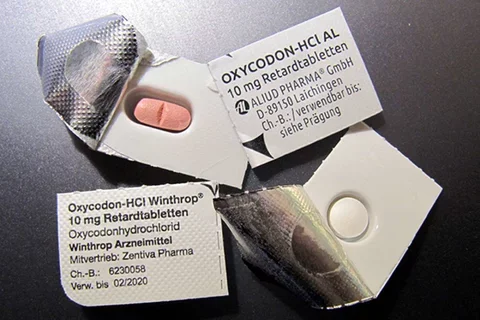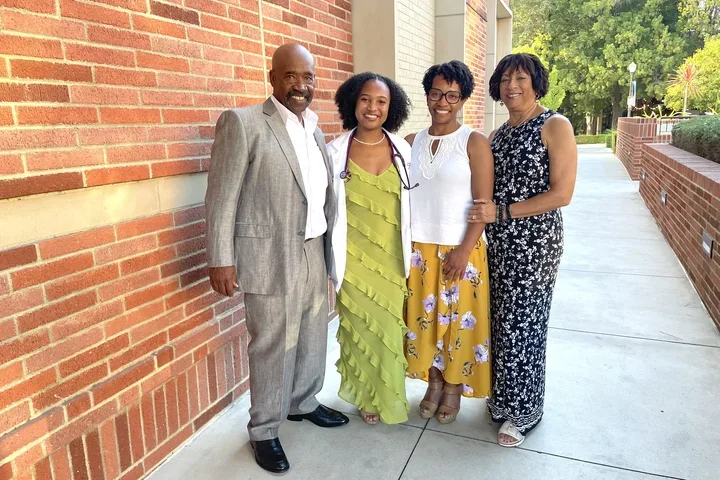What OTC naloxone means for the opioid crisis
The FDA published a notice last November encouraging companies to apply for over- the-counter status for some naloxone products.

The Food and Drug Administration has approved a life-saving medicine for opioid overdose to be sold over the counter, potentially as early as this year.
Wider access to naloxone, sometimes sold under the brand name Narcan, could reduce stigma while addressing the national spike in fatal overdoses, says UCLA Health’s Larissa Mooney, MD, director of the Division of Addiction Psychiatry.
“This movement has really happened because opioid overdoses are on the rise every year in the United States,” says Dr. Mooney, a professor of clinical psychiatry at the David Geffen School of Medicine at UCLA. “It’s such a safe and easy-to-administer medication, that the benefit of having it as widely available as possible is perceived to outweigh any risk of administration.”
Last November, the FDA published a notice encouraging companies to apply for over- the-counter status for some naloxone products. The agency said nasal spray and an auto-injector “may be approvable as safe and effective for nonprescription use.”
The action comes as data released last year by the Centers for Disease Control and Prevention found that opioid overdose deaths increased 15% from an estimated 70,029 in 2020 to 80,816 in 2021.
Reversing an overdose
Signs of an opioid overdose are slowed breathing, sedation and difficulty waking up. If a person stops breathing, their skin may turn bluish. Administering a dose of naloxone in a timely fashion will rapidly reverse symptoms caused by heroin, fentanyl or prescription opioid medications.
“You should always call 911 at the same time, but you do have this window where you can act quickly if you have the medication on hand,” Dr. Mooney says. “Often people are able to act more quickly in a situation where they suspect overdose than it might taken to summon emergency personnel.”
No medical training is required to safely give either a puff of nasal spray or an auto-injection device. Opioids are the only class of drugs that have a safe reversal agent that can be used by lay people, Dr. Mooney says.
The nasal spray is simple to use and includes directions. The pre-filled, tiny needle should be injected into the thigh and can go through clothing, if necessary. The device contains a speaker that plays instructions to guide the user through each step of the injection process. It also carries printed instructions on the label.
Dr. Mooney says naloxone can act in as little as three minutes by binding strongly to the opioid receptors in the brain and kicking the opioids off.
“You administer it and if it’s working, you would start seeing the person coming to and waking up,” she says.
If it turns out that opioids were not the cause of a person’s sedation and slowed breathing, naloxone is not harmful, she says.
“It’s so safe, it just won’t work,” Dr. Mooney says. “It won’t cause additional risk.”
Naloxone only lasts for 30 to 90 minutes, meaning that in some cases if a person has a long-lasting opioid in their system, a second dose may be needed if symptoms return. It’s so effective that it may result in symptoms of opioid withdrawal, including anxiety and nausea.
Dr. Mooney says there is some potential risk of agitation or confusion if someone wakes up in withdrawal. It's reasonable, she says, to step back and give the person some space while waking up to avoid any unpredictable movements or responses.
She notes that guidance from the federal Substance Abuse and Mental Health Services Administration recommends offering comfort, reassurance and an explanation of what’s happening.
The medication is safe to give to children who have accidentally consumed an opioid.
Expanding access
In recent years, states including California have sought to be make naloxone more readily available, particularly because of the growing use of fentanyl, a powerful synthetic opioid.
Dr. Mooney notes that many pharmacies can dispense naloxone without a prescription, but that people still have to come up to the counter to ask for it and pay for it.
She says doctors have become increasingly aware of the importance of naloxone and may prescribe it to patients who take opioids for chronic pain or who are in treatment for opioid addiction.
Some people who overdose on opioids may not even realize they are using them. Fentanyl, which is up to 50 times stronger than heroin, is increasingly being used to lace other drugs such as methamphetamine. A very small amount of fentanyl can cause an overdose.
“People may consume it unknowingly,” Dr. Mooney says. “If they have tolerance to fentanyl, it’s risky because of its potency. If they don’t have any tolerance, it’s even more risky.”
In Los Angeles County, accidental fentanyl overdose deaths increased by 1,280% from 2016 to 2021. Naloxone still works effectively, although people may sometimes need a second dose.
“It’s all the more reason that naloxone availability should be widespread,” Dr. Mooney says. “We have to increase public awareness and knowledge of how to obtain it and how to use it.”
Who should have it
Dr. Mooney says that people who could be at risk of an overdose should get naloxone and inform those close to them. Loved ones may want to acquire their own supply. Videos from the CDC and other sources show how to use the nasal spray and auto-injector.
“A family member who knows someone may be struggling with opioid use disorder should be aware of how to administer naloxone, what are the signs of overdose and where the naloxone is in the home,” Dr. Mooney says.
It’s not yet known how much over-the-counter products would cost. Prices currently vary widely depending on insurance status. In 2018, the average out-of-pocket cost for the uninsured was $250, but only $18 with insurance, according to a 2022 Rand Corporation study.
Dr. Mooney says that over-the-counter status could reduce stigma and encourage wider use.
“It just makes it more anonymous to obtain the medication,” she says. “It’s not with your insurance. It’s not in your medical record. You can just buy it privately.”
Over-the-counter status could also lead more public places to keep the drug on hand, similar to how automated external defibrillators (AEDs) for treating cardiac arrest are commonplace.
Courtney Perkes is the author of this article.
Take the Next Step
Learn more at UCLA Health’s Addiction Psychiatry Clinic.
Original Article: "What OTC naloxone means for the opioid crisis"



